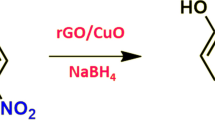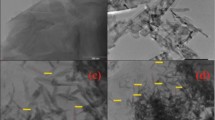Abstract
Copper and zinc composite oxide (CuZnO) was synthesized successfully via a sol–gel method and modified by silane coupling agent to prepare CuZnO@graphene oxide (CuZnO@GO) nanocomposites, with CuZnO nanoparticles (NPs) distributed on the GO nanosheets. The structural properties of prepared CuZnO@GO nanocomposites were studied by FT-IR and XRD techniques. SEM and TEM analysis showed the spherical morphology of CuZnO NPs with a diameter of 20–40 nm. The optical properties of synthesized products were estimated through UV–Vis DRS and PL spectroscopy, which suggested that CuZnO@GO nanocomposites had a widened absorption range from UV to visible region and a lower photogenerated carrier recombination rate than that of pure CuZnO NPs. The antibacterial mechanism of CuZnO@GO nanocomposites was investigated using gram-negative bacteria Escherichia coli and gram-positive bacteria Staphylococcus aureus as two model microorganisms. The antibacterial properties of CuZnO@GO nanocomposites on mixed bacteria were researched in the cooling water system. The results showed that when adding CuZnO@GO nanocomposites to E. coli or S. aureus suspension, the protein leakage after 20 h was 10.5 times or 8.3 times higher than that in the blank experiment. Furthermore, the antibacterial activity of CuZnO@GO nanocomposites in presence of visible light was found to be significantly enhanced as compared with control. Under visible light irradiation, the antibacterial rate of CuZnO@GO nanocomposites in circulating cooling water reached 99.09% when the mass fraction of GO was 17.5%, and more than 90% of bacteria were inactivated by 100 mg·L−1 CuZnO@GO nanocomposites in 60 min after four recycled runs.

Schematic of antibacterial mechanism of CuZnO@GO nanocomposites
Highlights
-
CuZnO@GO nanocomposites with excellent photocatalytic antibacterial activity were synthesized.
-
The antibacterial mechanism of CuZnO@GO nanocomposites was investigated using pure bacteria.
-
The antibacterial application of CuZnO@GO nanocomposites for complex bacteria was researched.
-
After four recycled runs, the antibacterial rate of CuZnO@GO nanocomposites was still up to 90%.













Similar content being viewed by others
References
Wang HB, Hu C, Hu XX et al. (2012) Effects of disinfectant and biofilm on the corrosion of cast iron pipes in a reclaimed water distribution system. Water Res 46(4):1070–1078
Batterman S, Eisenberg J, Hardin R et al. (2009) Sustainable control of water-related infectious diseases: a review and proposal for interdisciplinary health-based systems research. Environ Health Perspect 117(7):1023–1032
Zhang Y, Zhu Y, Yu J et al. (2013) Enhanced photocatalytic water disinfection properties of Bi2MoO6–RGO nanocomposites under visible light irradiation. Nanoscale 5(14):6307–6310
Krasner SW, Weinberg HS, Richardson SD et al. (2006) Occurrence of a new generation of disinfection byproducts. Environ Sci Technol 40(23):7175–7185
Jafry HR, Liga MV, Li QL et al. (2011) Simple route to enhanced photocatalytic activity of P25 titanium dioxide nanoparticles by silica addition. Environ Sci Technol 45(4):1563–1568
Chong MN, Jin B, Chow CWK et al. (2010) Recent developments in photocatalytic water treatment technology: a review. Water Res 44(10):2997–3027
Kasinathan K, Kennedy J, Elayaperumal M et al. (2016) Photodegradation of organic pollutants RhB dye using UV simulated sunlight on ceria based TiO2 nanomaterials for antibacterial applications. Sci Rep 6:1–12
Kumar R, Anandan S, Hembram K et al. (2014) Efficient ZnO-based visible-light-driven photocatalyst for antibacterial applications. ACS Appl Mater Interfaces 6(15):13138–13148
Liu C, Kong D, Hsu PC et al. (2016) Rapid water disinfection using vertically aligned MoS2 nanofilms and visible light. Nat Nanotech 11(12):1098–1104
Luo M, Liu Y, Hu JC et al. (2012) One-pot synthesis of cds and ni-doped cds hollow spheres with enhanced photocatalytic activity and durability. ACS Appl Mater Interfaces 4(3):1813–1821
Piccirillo C, Pinto RA, Tobaldi DM et al. (2015) Light induced antibacterial activity and photocatalytic properties of Ag/Ag3PO4-based material of marine origin. J Photochem Photobiol 296:40–47
Kumar S, Dhiman A, Sudhagar P et al. (2018) ZnO–graphene quantum dots heterojunctions for natural sunlight-driven photocatalytic environmental remediation. Appl Surf Sci 447:802–815
Choina J, Bagabas A, Fischer C et al. (2015) The influence of the textural properties of ZnO nanoparticles on adsorption and photocatalytic remediation of water from pharmaceuticals. Catal Today 241:47–54
Kavitha T, Gopalan AI, Lee KP et al. (2012) Glucose sensing, photocatalytic and antibacterial properties of graphene–ZnO nanoparticle hybrids. Carbon N Y 50(8):2994–3000
Sakthivel S, Neppolian B, Shankar MV et al. (2003) Solar photocatalytic degradation of azo dye: comparison of photocatalytic efficiency of ZnO and TiO2. Sol Energ Mat Sol C 77(1):65–82
Sirelkhatim A, Mahmud S, Seeni A et al. (2015) Review on zinc oxide nanoparticles: antibacterial activity and toxicity mechanism. Nano Micro Lett 7(3):219–242
Ghosh S, Goudar VS, Padmalekha KG et al. (2012) ZnO/Ag nanohybrid: synthesis, characterization, synergistic antibacterial activity and its mechanism. Rsc Adv 2(3):930–940
Yousefi R, Jamali SF, Cheraghizade M et al. (2016) Synthesis and characterization of Pb-doped ZnO nanoparticles and their photocatalytic applications. Mater Res Innov 20(2):121–127
Yu C, Yang K, Xie Y et al. (2013) Novel hollow Pt–ZnO nanocomposite microspheres with hierarchical structure and enhanced photocatalytic activity and stability. Nanoscale 5(5):2142–2151
Fakhri A, Azad M, Tahami S (2017) Degradation of toxin via ultraviolet and sunlight photocatalysis using ZnO quantum dots/CuO nanosheets composites: preparation and characterization studies. J Mater Sci Mater Electron 28(21):1–6
Wu W, Zhang S, Xiao X et al. (2012) Controllable synthesis, magnetic properties, and enhanced photocatalytic activity of spindlelike mesoporous α-Fe(2)O(3)/ZnO core-shell heterostructures. ACS Appl Mater Interfaces 4(7):3602–3609
Subhan MA, Uddin N, Sarker P (2015) Photoluminescence, photocatalytic and antibacterial activities of CeO2·CuO·ZnO nanocomposite fabricated by co-precipitation method. Spectrochim Acta A Mol Biomol Spectrosc 149(46):839–850
Liu J, Li F, Liu C et al. (2014) Effect of Cu content on the antibacterial activity of titanium–copper sintered alloys. Mater Sci Eng 35(1):392–400
Baek YW, An YJ (2011) Microbial toxicity of metal oxide nanoparticles (CuO, NiO, ZnO, and Sb2O3) to Escherichia coli, Bacillus subtilis, and Streptococcus aureus. Sci Total Environ 409(8):1603–1608
Zhao J, Wang Z, Dai Y et al. (2013) Mitigation of CuO nanoparticle-induced bacterial membrane damage by dissolved organic matter. Water Res 47(12):4169–4178
Cruz G, Gómez MM, Solis JL et al. (2018) Composites of ZnO nanoparticles and biomass based activated carbon: adsorption, photocatalytic and antibacterial capacities. Water Sci Technol 2017(2):492–508
Akhavan O, Azimirad R, Safa S (2011) Functionalized carbon nanotubes in ZnO thin films for photoinactivation of bacteria. Mater Chem Phys 130(1):598–602
Papageorgiou DG, Kinloch LA, Young RJ (2017) Mechanical properties of graphene and graphene-based nanocomposites. Prog Mater Sci 90:75–127
Pumera M (2013) Electrochemistry of graphene, graphene oxide and other graphenoids: review. Electrochem Commun 36(6):14–18
De JN, Allioux M, Oostveen JT et al. (2005) Optical performance of carbon-nanotube electron sources. Phys Rev Lett 94(18):1–4
Ueki Y, Aoki T, Ueda K et al. (2017) Thermophysical properties of carbon-based material nanofluid. Int J Heat Mass Transf 113:1130–1134
Hu W, Peng C, Luo W et al. (2010) Graphene-based antibacterial paper. ACS Nano 4(7):4317–4323
Akhavan O, Ghaderi E (2010) Toxicity of graphene and graphene oxide nanowalls against bacteria. ACS Nano 4(10):5731–5736
Lian P, Zhu X, Liang S et al. (2010) Large reversible capacity of high quality graphene sheets as an anode material for lithium-ion batteries. Electrochim Acta 55(12):3909–3914
He M, Wu T, Pan S et al. (2014) Antimicrobial mechanism of flavonoids against Escherichia coli, ATCC 25922 by model membrane study. Appl Surf Sci 305:515–521
Banerjee M, Mallick S, Paul A et al. (2010) Heightened reactive oxygen species generation in the antimicrobial activity of a three component iodinated chitosan-silver nanoparticle composite. Langmuir 26(8):5901–5908
Novakowski KE, Loukov D, Chawla V et al. (2017) Bacterial binding, phagocytosis, and killing: measurements using colony forming units. Methods Mol Biol 1519:297–309
Zhang CC, Chen MX, Xu XY et al. (2014) Graphene oxide reduced and modified by environmentally friendly glycylglycine and its excellent catalytic performance. Nanotechnology 25(13):1–12
Yan B, Yue G, Yang J et al. (2013) On the bandgap of hydrogenated nanocrystalline silicon intrinsic materials used in thin film silicon solar cells. Sol Energ Mat Sol C 111(1):90–96
Lim J, Shin K, Kim HW et al. (2004) Effect of annealing on the photoluminescence characteristics of ZnO thin films grown on the sapphire substrate by atomic layer epitaxy. Mater Sci Eng 107(3):301–304
Yang J, Zheng J, Zhai H et al. (2010) Orented growth of ZnO nanostructures on different substrates via hydrothermal method. J Alloy Compd 489(1):51–55
Zhang Y, Mu J et al. (2007) Controllable synthesis of flower- and rod-like ZnO nanostructures by simply tuning the ratio of sodium hydroxide to zinc acetate. Nanotechnology 18(7):1–6
Liu S, Zeng TH, Hofmann M et al. (2011) Antibacterial activity of graphite, graphite oxide, graphene oxide, and reduced graphene oxide: membrane and oxidative stress. ACS Nano 5(9):6971–6980
Wahab R, Siddiqui MA, Saquib Q et al. (2014) ZnO nanoparticles induced oxidative stress and apoptosis in HepG2 and MCF-7 cancer cells and their antibacterial activity. Colloid Surf B 117(7):267–276
Padmavathy N, Vijayaraghavan R (2011) Interaction of ZnO nanoparticles with microbes—a physio and biochemical assay. J Biomed Nanotechnol 7(6):813–822
Lv XJ, Fu WF, Chang HX et al. (2012) Hydrogen evolution from water using semiconductor nanoparticle/graphene composite photocatalysts without noble metals. J Mater Chem 22(4):1539–1546
Zhang L, Ding Y, Povey M et al. (2008) ZnO nanofluids—a potential antibacterial agent. Prog Nat Sci Mater 18(8):939–944
Liu S, Hu M, Zeng TH et al. (2012) Lateral dimension-dependent antibacterial activity of graphene oxide sheets. Langmuir 28(33):12364–12372
Some S, Ho SM, Dua P et al. (2012) Dual functions of highly potent graphene derivative poly-l-lysine composites to inhibit bacteria and support human cells. ACS Nano 6(8):7151–7161
Liu F, Zhao CC, Xia L et al. (2011) Biofouling characteristics and identification of preponderant bacteria at different nutrient levels in batch tests of a recirculating cooling water system. Environ Technol 32(8):901–910
Acknowledgments
This research was financially supported by Natural Science Foundation of Shandong Province, China (ZR201702140013).
Author information
Authors and Affiliations
Corresponding author
Ethics declarations
Conflict of interest
The authors declare that they have no conflict of interest.
Rights and permissions
About this article
Cite this article
Li, X., Che, Y., Lv, Y. et al. Synthesis and characterization of CuZnO@GO nanocomposites and their enhanced antibacterial activity with visible light. J Sol-Gel Sci Technol 89, 672–684 (2019). https://doi.org/10.1007/s10971-018-4872-y
Received:
Accepted:
Published:
Issue Date:
DOI: https://doi.org/10.1007/s10971-018-4872-y




